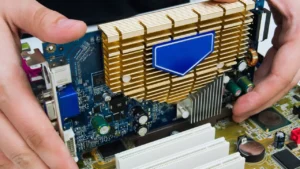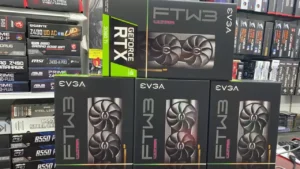Yes, ideally both monitors in a dual-monitor setup should be connected to the graphics processing unit (GPU) for optimal performance and functionality. This is especially important for tasks that demand significant graphical processing power, such as gaming, video editing, and 3D rendering.
Here’s a deeper dive into why connecting both monitors directly to the GPU is beneficial:
Understanding PCIe Slots and Lanes
Understanding PCIe (Peripheral Component Interconnect Express) slots and lanes is crucial in this context. These slots on your motherboard connect various internal components, including the GPU, to the CPU. Each slot offers a specific number of “lanes,” which essentially determine the bandwidth available for communication between the connected device and the CPU.
Different types of PCIe slots (x1, x4, x8, x16)
PCIe slots come in different configurations, denoted by “x” followed by a number, indicating the number of lanes they offer. Common slot types include:
- x1: Provides the least bandwidth, suitable for low-bandwidth devices like network cards.
- x4: Offers moderate bandwidth, often used for storage devices like SSDs.
- x8: Provides higher bandwidth, commonly used for high-performance network cards and some GPUs.
- x16: Offers the highest bandwidth and is specifically designed for high-performance graphics cards.
Importance of PCIe x16 for gaming
For smooth gameplay and optimal graphics performance, it’s essential to use a PCIe x16 slot for your GPU. This ensures the graphics card has access to the full bandwidth it needs to function efficiently.
How Does Slot Selection Affect Performance?
Using a lower bandwidth slot like PCIe x8 for your GPU can bottleneck its performance, leading to:
- Stuttering or lag in games
- Reduced frame rates
- Lower graphics quality
How to Set Up Dual Monitors?
Here’s a quick guide on setting up dual monitors:
1. Proper Connections and Display Settings:
- Connect both monitors to the available video ports on your GPU, typically HDMI, DisplayPort, or DVI.
- Power on your system and ensure both monitors are detected by your operating system.
- Access your display settings and configure the arrangement and resolution for each monitor according to your preference.
2. Rearranging Displays:
- You can physically rearrange the monitors on your desk to adjust their positions as needed.
- In your display settings, you can then drag and drop the monitor icons to match their physical arrangement.
3. Adjusting “Multiple Displays” Setting:
Within your display settings, choose how you want to use the additional monitor. Options include extending your desktop across both monitors, duplicating the same content on both, or using one monitor as the primary and the other for specific tasks.
Does it Matter Which PCIe Slot You Use for Your GPU?
Ideally, you should use the primary PCIe x16 slot for your GPU to achieve optimal performance. This slot offers the highest bandwidth and ensures your graphics card can function at its full potential.
Here are some additional points to consider:
1. Optimal Performance with Primary PCIe x16 Slot:
- The primary PCIe x16 slot is typically the first full-sized slot closest to the CPU. This slot is specifically designed for graphics cards and provides the highest bandwidth for optimal performance.
2. Use of Secondary Slots for Multi-GPU Setups:
- In rare cases, you might use a secondary PCIe x8 or x16 slot for a multi-GPU setup. However, this can introduce performance limitations due to reduced bandwidth compared to the primary slot.
3. Compatibility Concerns with Mini ITX and Micro ATX Motherboards:
- Some smaller form-factor motherboards, like mini ITX and micro ATX, might only have one full-sized PCIe x16 slot. In such cases, using that slot for your primary GPU is essential, as other options might not offer sufficient bandwidth.
By connecting both monitors to the GPU and using the optimal PCIe slot, you can ensure your dual-monitor setup delivers the best performance and a seamless user experience.








